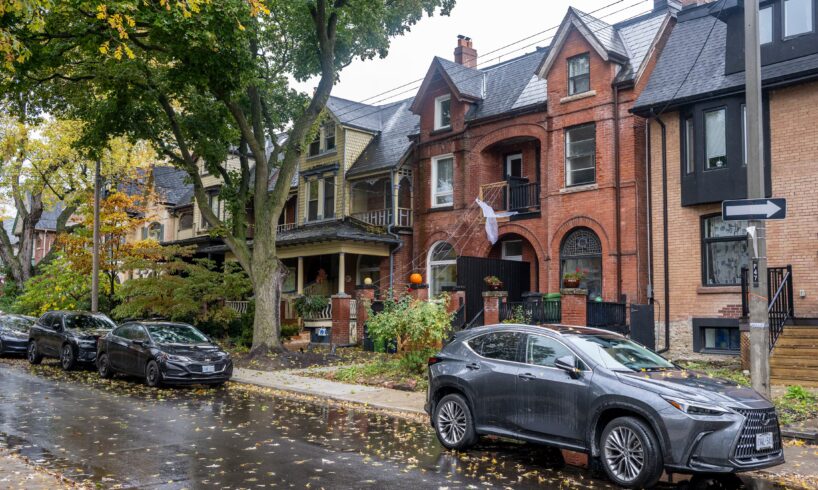
Open this photo in gallery:
Houses in the Annex area.EDUARDO LIMA/The Globe and Mail
In the late 1960s, the urbanist Jane Jacobs bought a cavernous rooming house on Toronto’s Albany Avenue. She and her husband – a freelance writer and a young architect – moved their family into the Bohemian Annex.
Forty years later, the house sold for $850,000 and got renovated. It’s now worth millions, and sports an Audi SUV in the driveway. The building remains; everything else has changed.
It’s a cautionary tale for Toronto and its heritage planners, now considering a Heritage Conservation District study for the western Annex. The irony: the more faithfully the area’s charm is preserved, the faster its social variety disappears.
Make no mistake: the study, launched with a drop-in event in late October, aims to block new development, at the moment that broader planning changes promise denser construction.
The study is backed by the powerful Annex Residents’ Association. After a long pause, councillor Dianne Saxe revived it, also pushing another nearby heritage measure on Palmerston Boulevard, citing “community priorities” in “matters of design.”
“Community priorities” masquerading as heritage policy is exactly what Ontario’s Housing Affordability Task Force warned about in 2022. “Heritage preservation has … become a tool to block more housing,” the report noted.
The evolving architecture of affordable housing
The issue is live in the Annex. A provincial policy now defines “Mass Transit Station Areas” covering much of the neighbourhood, mandating higher density. The city plans to adjust zoning accordingly, but heritage rules could and likely will intervene.
The study area, roughly from Bedford Road to Bathurst Street along Bloor West, was built up around 1900. It contains hundreds of houses, including ornate Edwardian piles – the bread and butter of local heritage protection – and dozens of mid-century apartments. The latter sparked a backlash: in the 1970s, Reform-era leadership locked down the area against change.
Since then, the Greater Toronto Hamilton Area has doubled in population. The Annex, by contrast, has fewer residents than 50 years ago. It remains predominantly white and affluent, except in two specific pockets of apartments along St. George Street and near Bloor and Spadina, whose tenants reflect the city’s diversity.
The city needs more workhorse apartment buildings. Some houses will have to go. But a heritage district would give planners broad discretion to interfere with new projects. For 20 years, heritage staff have increasingly obstructed Toronto’s growth, emphasizing the value of private interiors or mediocre shops over contemporary needs.
One overreach, applying a heritage frame to hundreds of indifferent main-street buildings, provoked a nuclear reaction from Premier Doug Ford, who in 2022 partially demolished the Ontario Heritage Act.
“Toronto to deem nearly 1,000 buildings as heritage, but are they really?”
Such pushback should have inspired reflection. What’s the right balance between preservation and growth? Is it defensible to guard Edwardian semis while apartment buildings with hundreds of residents – rarely deemed heritage – get demolished?
There’s a strong case that some of these buildings should go. The city long ago protected the neighbouring East Annex as a heritage district, along with a stretch of Madison Avenue. Those places include the cream of Toronto’s Victorian and Edwardian domestic architecture. The streets of the West Annex have fewer first-rate buildings.
Its social history, residents will tell you, is one of diversity and change. But recently, houses have more often shifted from multiplexes and rooming houses like Jacobs’s into single-family homes. Tight planning rules have aided gentrification, and that will likely continue until the West Annex mirrors its even wealthier neighbours.
If a new heritage district is created, it should acknowledge the tradeoffs and explicitly define how the area will change. Where will this area accommodate many new residents? If the goal is to protect old houses, what incentives can the city provide to convert them into apartments? How will existing tenants be protected? And with all that in mind, which old buildings should be dispensed with?
For decades, Toronto has planned the city one skirmish at a time, treating each policy choice as isolated from the rest. The outcome is a spiky geography of privilege: towers on one block, fossilized affluence on the next. “Cities have the capability of providing something for everybody,” Ms. Jacobs wrote, “only because, and only when, they are created by everybody.” In today’s Annex, that principle has been priced out.





